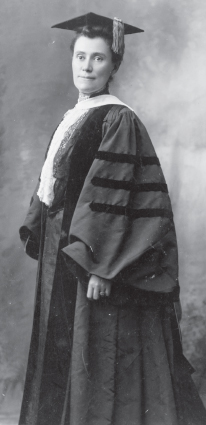

Black educator and former slave Lucy Craft Laney founds a teachers college called the Haines Normal Institute in Atlanta, Georgia.

Daughters of the American Revolution (DAR) is formed; it is a group that honors the heritage of Americans who can trace their lineage in this country back to the late 1700s.

Kate Gleason, who served as bookkeeper for the family business from the age of fourteen and became the first woman to enter Cornell University’s engineering program, is called back home by her father to work for the family company. Becoming secretary-treasurer, she markets gear-cutting machinery internationally and helps the firm grow into a nationally prominent producer. After leaving the company, she is appointed receiver of a bankrupt company in 1914, probably the first woman in the United States to be so named, and in 1918 becomes a bank president. In 1998, the Rochester Institute of Technology names the Kate Gleason College of Engineering in her honor. The Gleason Corporation is still in existence today in Rochester, New York.

Prominent feminist and reformer Alice Stone Blackwell (daughter of Lucy Stone) leads the movement to reconcile the two competing factions of the woman’s suffrage movement. The differences between the groups are based on differences in strategy: one favors state-by-state campaigns, the other a federal constitutional amendment. Stone Blackwell helps the National American Woman Suffrage Association (NAWSA) combine both of these techniques in order to secure the passage of the Nineteenth Amendment. When suffrage becomes a reality, NAWSA reorganizes as the League of Women Voters.

Ida Gray Nelson becomes the first black woman to earn a dental degree.

Rose Markward Knox takes over a gelatine business upon the death of her husband and runs it for more than forty years, during which time it becomes the largest such company in the United States. She is still chair of the board of directors at the time of her death. Knox is the first woman to be elected director of the American Grocery Manufacturers Association.

Martha Matilda Harper develops the modern franchising system in her chain of skin and hair care salons. She uses a picture of herself with her long hair as part of her advertising.

Sister Mary Katharine Drexel founds the religious order Sisters of the Blessed Sacrament for Indians and Colored People in the Philadelphia, Pennsylvania, area. She is canonized as a Roman Catholic saint in 2000.

Mary Emma Woolley becomes the first woman admitted to Brown University. She will also become the first woman Phi Beta Kappa and the first woman to represent the United States at a major diplomatic conference. She later becomes president of Mount Holyoke College.

Author, folklorist, and defender of Native American rights Harriet Maxwell Converse is the first Anglo woman to become an honorary chief of a Native American tribe, the Seneca Nation.

Author, educator, and scholar Anna Julia Cooper, born a slave but the fourth African American woman to earn a Ph.D. degree, publishes A Voice from the South: By a Woman from the South, an early example of black feminism. Her life is dedicated to educating fellow blacks. A traffic circle in Washington, D.C., is named in her memory.

Feminist and writer Charlotte Perkins Gilman publishes The Yellow Wallpaper, about a woman driven mad in her repressive marriage. Gilman becomes the leading feminist theoretician of her generation.